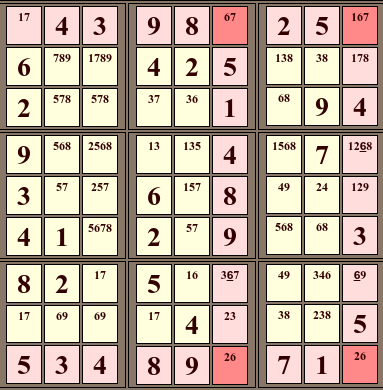I divide the solving techniques into two categories: standard and advanced. Many published puzzles can be solved using just the standard technique, including even the puzzles labelled “Hardest” in the Sunday Toronto Star.
The Standard Technique
Here are the basic steps:
0) First, for each blank cell on the grid, determine all the possible values the cell can have. This can be done by looking at the seed values in all other cells of the associated groups (row, column, and 3×3 square).
1) Whenever the value of a cell is known, that value can be eliminated from the list of possible values for all other cells of the associated groups.
2) Look for an unsolved cell that has just one possible value. That becomes the value of the cell. Then apply rule 1.
3) Look through all the unsolved cells of a group looking for a possible value that exists only in one cell. That value now becomes the value of that cell. Then apply rule 1.
Repeat steps 1, 2, and 3 until either all cells are solved or you reach an impasse. If the puzzle is not yet completely solved, then you need to use the advanced techniques.
With a bit of practice, for most puzzles, you don’t actually have to list out all possibilities for the unsolved cells. When starting to solve a puzzle, you can often easily spot several cells where the value is obvious. For some puzzles then, the challenge is to write down the solution in pen without jotting down any notes. But for many puzzles, at least some annotation is needed to keep track of possibilities.
The Advanced Techniques
In the standard technique, you look at just just one cell or one possible value at a time. In the advanced techniques, you look at several cells or possible values. Using an advanced technique, you don’t actually determine a cells value – you can only eliminate possibilities. You can then continue solving using the standard technique.
Single Group Analysis
Double or triple cells
In any group (row, column, or square), look for two cells with the same two possible values, and only those two values. The two values must exist in either of those two cells, and can therefore be eliminated from the other cells of the group.
Likewise, you can look for three cells in a group with the same three possible values, and no others. These values must exist within these three cells, and so can be eliminated from the other cells of the group. Note that not all three values have to exist in all three cells for this technique to apply. For example, you could have three cells with the possibilities {1,2,3}, {2,3}, and {1,3}.
Double or triple possibilities
Look for two possibilities that exist only in two cells of a group. Since these possibilities must exist within these two cells, all other possibilities can be eliminated from the two cells.
You can also look for three possibilities that exist in only three cells of a group, and eliminate all other possible values from the three cells.
Partitioning
Actually, the above two techniques are simply flip sides of the same general technique. For example, say you have a group with eight unknown cells. Looking for six cells with the same six possibilities is the same as looking for two possibilities that exist in only two cells. Either way, possibilities may get eliminated from the two cells.
Therefore, to generalize the technique: Partition the group into two groups of n and m cells. If there are exactly npossibilities present in the group of n cells, then these possibilities can be eliminated from the cells of the other group.
This is just another way to express the technique. Use whichever way makes sense to you.
Intersection of two groups
Look at the intersection of a 3×3 square (call it set A) and either a row or a column (call it set B). There are three cells in the intersection, which we’ll call set C. (That is, C=A∩B.) For this method to work, there must be at least two unknown cells in the intersection.
Now then, if some possibility x exists in set C but not in A-C, then that possibility also cannot exist in B-C. Thus, possibility x can then be eliminated from the cells of B not part of the intersection.
Intersection of four groups
This technique is the most complicated of all, and is best illustrated with an example. In the following puzzle, we reach an impasse:

To break the impasse, we need to look at two rows and two columns at the same time. In this diagram, look at the four cells where the marked rows and columns intersect. Note that the possibility “6” occurs in all four cells. Note also that in the marked rows, possibility “6” occurs only in the intersecting cells. Thus, the value “6” must appear either in the top right and bottom left cells, or in the top left and bottom right cells. Either way, “6” cannot appear in any other cell in the two marked columns, and can therefore be eliminated from those other cells. In this case, the three underlined sixes can be eliminated.
Note that this technique doesn’t apply to just intersecting rows and columns. You also have to consider other combinations of four intersecting rows, columns, and squares:
- 2 rows and 2 columns
- 2 rows, 1 square, and 1 column
- 2 rows and 2 squares
- 1 row, 1 square, and 2 columns
- 2 columns and 2 squares
You could extend this technique to three rows intersecting with three columns. But again, I doubt you’ll ever have to resort to that.
